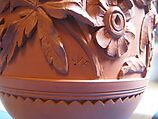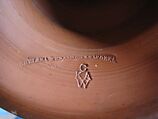Vase
Manufacturer Chelsea Keramic Art Works American
Decorator George W. Fenety
The Chelsea Keramic Art Works was the first American ceramics firm to designate itself an "art pottery." It was founded in Chelsea, Massachusetts, by members of the Robertson family, all of whom had honed their skills in the ceramics industry in Britain before coming to this country. The remarkably eclectic nature of the pottery produced by the firm in the late 1870s was furthered by the diversity of outside artists working there. The Canadian-born artist George w. Fenety was closely associated with the Chelsea pottery in the initial part of his career. By 1871 Fenety had settled in Boston, where he was employed as an engraver and carver. He was working with Hugh Robertson and his family as early as 1877, the year a vase he had ornamented with "convolvulus vine, leaves & flowers in high relief" was given to the Museum of Fine Arts, Boston. Fenety designed and carved this magnificent redware vase, and signed the vase on its side with his distinctive monogram. Carved in high relief and rendered naturalistically, the flowering plants conform to the philosophical tenets of John Ruskin, the revered English author who extolled the beauty of nature unadorned. Yet he horizontal bands impose a sense of restraint and formality.
This vase is from the Robert A. Ellison Jr. Collection of American art pottery donated to the Metropolitan Museum in 2017 and 2018. The works in the collection date from the mid-1870s through the 1950s. Together they comprise one of the most comprehensive and important assemblages of this material known.
This image cannot be enlarged, viewed at full screen, or downloaded.
This artwork is meant to be viewed from right to left. Scroll left to view more.





